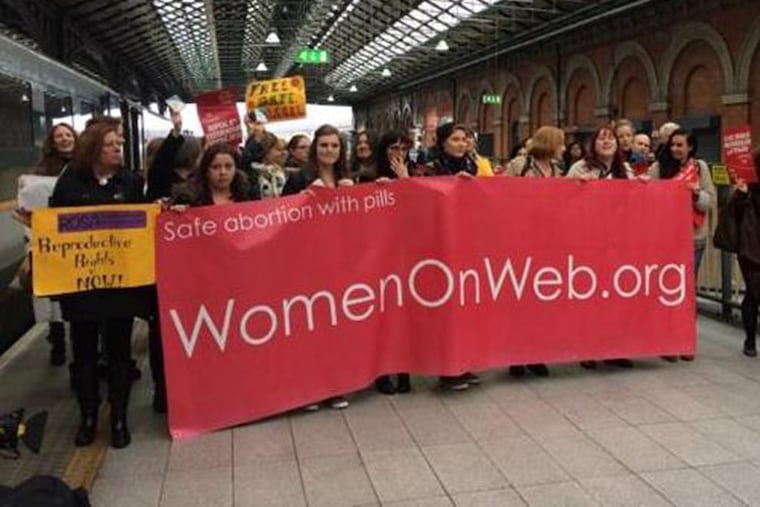Do-it-yourself abortion isn’t driving decline in rates, analysis finds. But that could change.
Online abortion pills are changing the concept of secret, self-induced abortion.

The welcome but somewhat inexplicable four-decade decline in the U.S. abortion rate has not been skewed by uncounted abortions that are done privately without medical supervision, according to a new analysis.
Guttmacher Institute researchers reviewed two decades of research on “self-managed” abortion, an age-old practice that has been radically changed by the availability of mail-order abortion pills from online sources that U.S. regulators consider illicit.
Published studies of women have found that only 1% to 5% have ever tried to end a pregnancy on their own — although that fraction is probably growing, the Guttmacher researchers concluded.
“The drugs misoprostol and mifepristone have become increasingly available over the internet, as have websites that provide accurate information about how to safely and effectively self-manage abortion,” said senior policy manager Megan K. Donovan, a coauthor of the new analysis. “Given these trends, it makes sense that self-managed abortion may be on the rise.”
Guttmacher, based in New York City, supports abortion rights, but activists on both sides of the debate cite its meticulous research.
» READ MORE: The U.S. abortion rate falls to lowest level since Roe v. Wade
Two months ago, Guttmacher published its latest survey of U.S. abortion facilities, which gives a more complete picture than federal data. Both the number and rate of abortions in 2017 fell to historic lows — significantly lower than in 1973 when the Supreme Court’s Roe v. Wade decision legalized abortion nationwide. The 2017 rate of 13.5 abortions per 1,000 women translated to 862,000 in-clinic procedures.
What explains this downward trend? Birth rates have also been falling, so Guttmacher and other experts attribute the declines to better contraception and less sexual activity among young people. Legislative efforts to ban or restrict abortion were not the primary driver, because declines occurred across all regions and in states with relatively liberal abortion laws.
But that September report acknowledged it could not account for self-managed abortions.
The new report, published in Health Affairs Blog, reviewed the limited available data from studies going back to 1999. Not only was the incidence of self-managed abortion 5% or less, but many attempts were unsuccessful.
However, indirect measures of do-it-yourself abortions suggest a break with the past, Donovan and coauthor Rachel K. Jones found. Google searches related to self-managed abortion increased almost sevenfold between 2011 and 2015, to 700,000. And Guttmacher’s latest survey found 18% of abortion clinics treated at least one patient who had tried to abort on her own, up from 12% in 2014.
Abortion foes have warned that medication-induced abortion endangers women’s health ever since mifepristone was approved in the U.S. 19 years ago. The Food and Drug Administration imposed strict prescribing and dispensing restrictions. Even so, the drug regimen now accounts for nearly a third of all abortions.
Abortion rights supporters say the method has proved to be very safe, even when doctors are not directly involved. For years, Women on Web, founded by Dutch physician Rebecca Gomperts, has shipped prescription abortion pills to women in countries where terminating a pregnancy is illegal. Last year, Gomperts launched Aid Access to provide the same service to U.S. women.
Ushma Upadhyay, a public health scientist and researcher at the University of California, San Francisco, listed other web-based initiatives that support self-managed abortion: PlanCpills.org, Women Help Women, ProgressFlorida.
“Digital health is a growing field,” she said. “It is not surprising that it is reaching abortion care.”
Abortion rights activists don’t agree on how much medical support women seeking the procedure need or how to provide it. But they agree with Guttmacher that self-managed abortion is growing.
“It provides the convenience, privacy, and autonomy that many women want,” said Elisa Wells, codirector of PlanCpills.org, which gets about 40,000 clicks a month. “We believe it’s inevitable and unstoppable.”
Abigail Aiken, a reproductive health researcher at the University of Texas at Austin, said: “We need policymakers to understand two things. First, putting barriers in the way of clinic access will not stop all abortions. And second, we need models of abortion care that meet a full spectrum of preferences and needs.”